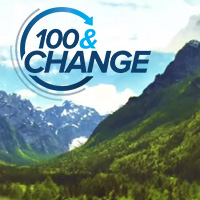Access Living President and CEO Marca Bristo shares how a phone call and lunch led to a partnership between MacArthur and Access Living on how to integrate inclusion in the semi-finalists round of 100&Change.
It started with a phone call and a lunch. Ever since the MacArthur 100&Change competition was announced, something was eating at me. Having worked in the disability rights movement for nearly 40 years, I was all too familiar with the historical patterns of exclusion in civic life, including organized philanthropy and the nonprofit community.

The paradigm revolution led by the global disability rights movement had ushered in the Americans with Disabilities Act and the United Nations Convention on the Rights of Persons with Disabilities. The movement's credo, Nothing About Us Without Us, had resulted in major changes in law and policy and has remarkably altered the world around us. Notwithstanding that progress, old ideas, stereotypes, and prejudice take much longer to eradicate. Such change only happens when enlightened leaders, working with empowered citizens, unite to shatter those harsh and unyielding beliefs.
MacArthur's announcement, bold in its concept, ignited in me the need to act so this amazing opportunity didn't leave us behind.
While some foundations and corporations have taken initiative to include people with disabilities, many more have excluded us from the very spaces intended to advance inclusion. Diversity, Equity, and Inclusion (DEI) initiatives until very recently made no mention of people with disabilities. Many still do not. Such exclusion across all sectors has resulted in the world's one billion disabled people being the most impoverished, illiterate, unemployed, and segregated segment of the population.
MacArthur's announcement, bold in its concept, ignited in me the need to act so this amazing opportunity didn't leave us behind. I invited MacArthur's President, Julia Stasch, to lunch prepared with my talking points to "sell her" on the idea. However, she beat me to the punch. She said, "We have to make sure 100&Change includes people with disabilities," and asked if we would help. Thus, began a partnership and process between the foundation team and Access Living. By this time the eight semi-finalists had been selected, so we were challenged by how to integrate inclusion in the remainder of the process. Susan Sygall, President of Mobility International and a 2000 MacArthur Fellow, and I worked together to review and provide input on the competing concepts. Susan gave the semi-finalists a specific critique using a disability lens; Access Living developed the 100&Change accessibility and inclusion checklist, a self-assessment tool. The semi-finalists were provided both to guide the rest of their program development, and we then critiqued their refined submissions.
Semi-finalists were asked to self-assess the degree to which people with disabilities were involved in the planning, staffing, and implementation of their projects.
Semi-finalists were asked to self-assess the degree to which people with disabilities were involved in the planning, staffing, and implementation of their projects. Impact on people with disabilities as well as mechanisms for reasonable accommodation, ensuring accessibility of both space and technology, outreach, communications, and evaluation, were all emphasized.
So now we wait. And wonder. When there is $100 million in play, will the all too often excuses like, "we can't afford it," or "our project isn't really about disability," or "we couldn't find people with disabilities," or "we tried and it didn't work," still exist? Or, will the need for disability inclusion result in the same creativity that has benefitted everyone, giving the world solutions such as amplification on telephones, computers that talk, curb cuts used by baby strollers, and captioning in noisy places. I certainly hope that this time the process will result in different outcomes. The world is watching.



